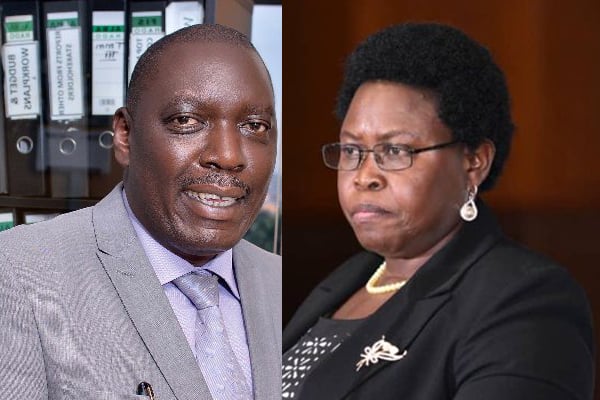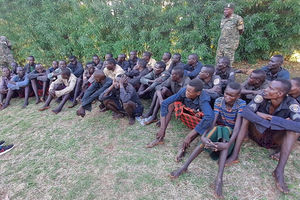Experts say student loans slant needs urgent action

Combo: The HESFB executive director, Mr Michael Wanyama (L) and junior Education minister, Dr Joyce Moriku Kaducu (R)
What you need to know:
- Mr Michael Wanyama, the HESFB executive director, says the board grapples with low funding, which makes it difficult to fully finance the loan scheme and implement its programme.
Key players in academia have warned of dire consequences waiting for Uganda’s education sector if long-standing irregularities in its loan scheme are not cured.
A number of stakeholders Saturday Monitor spoke to faulted government functionaries for the ills, especially plaguing the Higher Education Students’ Financing Scheme. They said the scheme is, among others, grossly managed.
In his latest report, Auditor General John Muwanga drew attention to historical regional imbalances. The matter of how the scheme keeps growing at a slant occupied a disproportionate part of proceedings the Committee on Commissions, Statutory Authorities and State Enterprises (Cosase) held last month.
Mr Stephen Mukitale, the former Buliisa County lawmaker, reckons the skew that privileges some sub-regions over others such as Karamoja, Acholi, and West Nile “is just a bigger symptom of the much bigger problem.”
During a three-week interface with the administrators of the Higher Education Students’ Financing Board (HESFB), Cosase also discovered that students studying Science, Technologies, Engineering, and Mathematics (STEM) subjects are privileged over those immersed in humanities and the social sciences.
Besides humanities and the social sciences still being relevant, most schools in rural areas and backwaters are not equipped to competently teach STEM subjects. The wealthy, Mr Mukitale opines, are inclined to set up schools equipped with laboratories in urban and peri-urban areas. “It is unfortunate that we are building a Uganda of the very rich because their children are the ones going to the best schools,” Mr Mukitale told Saturday Monitor, adding, “Clearly we are building a divided Uganda.”
“It is a fact that the students who pass sciences are not in poor schools and communities because it takes resources for a child to pass sciences which schools in needy communities don’t have,” the Country Director of StiR Education in Uganda, Mr Modern Musiimenta, says.
StiR Education is an international non-governmental organisation that supports education systems in Uganda.
Many other stakeholders join Mr Musimenta in expressing fears that this discriminatory system will exacerbate poverty in sub-regions with little or no beneficiaries of the loan scheme.
Appearing before Cosase, Dr Joyce Moriku Kaducu—a junior Education minister—concedes to the presence of the glaring imbalances and above all their impact.
She says while Cosase was “right to note that the numbers are not equitably distributed”, efforts are currently being channelled towards remodelling the implementation approach so that equity is realised throughout the entire allocation process.
Problems galore
Mr Michael Wanyama, the HESFB executive director, says the board has traditionally grappled with low funding, which makes it difficult to fully finance the loan scheme and implement its programme across the country.
The Integrated Loan Management Information System (ILMIS) is in dire need for an upgrade so that it can include other modules such as the human resource system, records management as well as the accounting structure.
Mr Wanyama told Cosase last month that HESFB struggled to effectively oversee and implement the demands of the scheme since it has only 28 of the 65 approved staff. HESFB has been in existence for nine years.
This, however, should not be a reason for poor performance by the entity, with the Cosase vice chairperson, Ms Lucy Akello, underscoring that HESFB administration should have focused on fairness and equity while implementing the scheme throughout the nearly decade-long spell it has been running.
“It is just incompetence and it has nothing to do with staffing levels,” Ms Lucy Akello, the Cosase vice chairperson, told Saturday Monitor, adding that her counterparts had concluded investigations into the matter and since embarked on compiling the final report that will soon be tabled before Parliament.
Remedial action
Ms Akello says government should incorporate the quota system into the scheme. Such affirmative action, she adds, will ensure “that everybody is able to benefit. Ultimately, the quota system will in her book ensure that “we will utilise the little resources equally and fairly.”
Mr Mukitale concurs with Ms Akello, saying a regional-based system will address historical imbalances. The need for transparency in the process of awarding the loans can also not be understated as per the former Buliisa County lawmaker.
Mr Mukitale also wants such plans to be complemented with the erection of vocational institutions at regional levels so that students who fail to secure loans to finance their academics get enrolled and skilled under the vocational outlets.
“We should try as much as possible to make sure we go back to what Uganda was at foundation level. We should run regional governments, [and] educational opportunities must be in every region,” he says.
Mr Musiimenta suggests that the loan scheme be realigned “to make it achieve the objectives it was created for—filling the equity gap in access to education services in the country.”
Dr Kaducu describes the proposal for a quota system as being “good.” She, however, says “it has to first be handled with the policy.”
Background
Since its inception in 2014, the HESFB management reported to Parliament that only 13,405 beneficiaries have been afforded and supported in the scheme.
This includes 1,201 beneficiaries in 2014; 1,273 in 2015; 1,325 in 2016; 1,448 in 2017; and 2,943 in 2018. In 2019, some 1,851 students benefited. There was a drop in 2020 (1,146) before it picked up in 2021 (1593). In 2022, a paltry 625 people benefitted as the government grappled with a living costs crisis.



